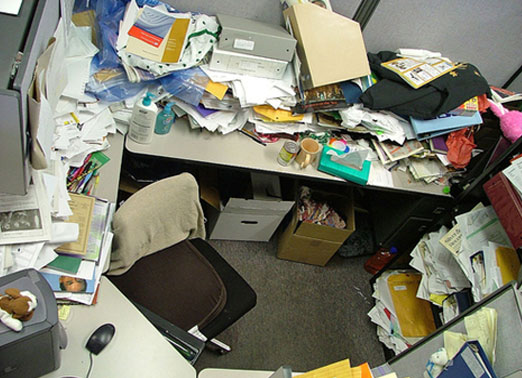The average executive wastes six weeks every year searching for paper, according to certified professional organizer Ellen Delap. Maintaining an organized office where you can find items quickly and easily saves time and makes you more efficient, effective and productive. Here, Delap outlines some strategies and tools anyone can use to keep a home office, commercial office or cubicle organized and effective.
By Meridith Levinson
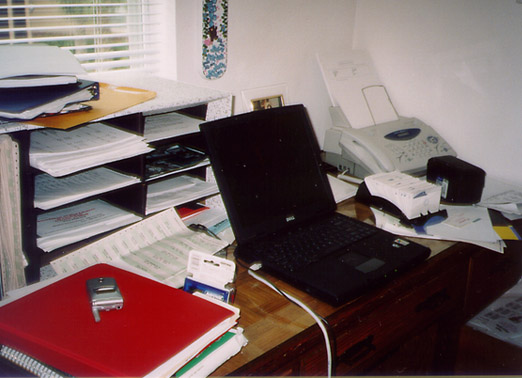
Paper, paper everywhere and not a spot to think
One of the biggest challenges professionals face in keeping their offices organized is the ongoing, onslaught of paper, says Delap. Despite e-mail, iPads and electronic services like online bill payment, “Paper is coming at them so fast; they don’t have time to deal with it.”
That’s why Delap recommends having a space for “unprocessed paper,” where you can keep bills, receipts, memos, etc. that you can’t immediately address. Of course, you’ll have to deal with that paper eventually. The next slide explains how to stay on top of it.
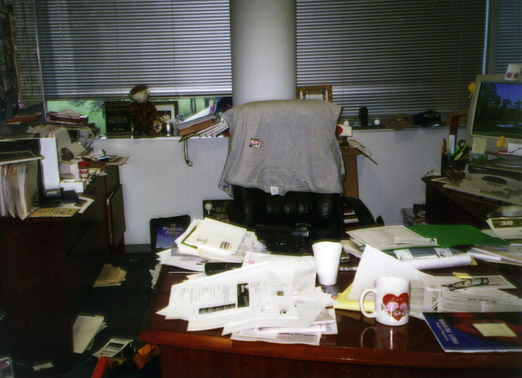
Sort relentlessly
Believe it or not, this is the same office as in the previous slide. Delap urges pack rats to spend five minutes each day sorting, shredding or recycling the paper festooning their offices. That will help you get on top of it and feel less overwhelmed. If you have an additional hour each week that you can devote to organizing your office, do it, adds Delap. “I liken organization to brushing your teeth: You can either brush twice a day or 14 times on Saturday.” The vertical sorter on the right side of the desk pictured here provides a space for “unprocessed paper.”
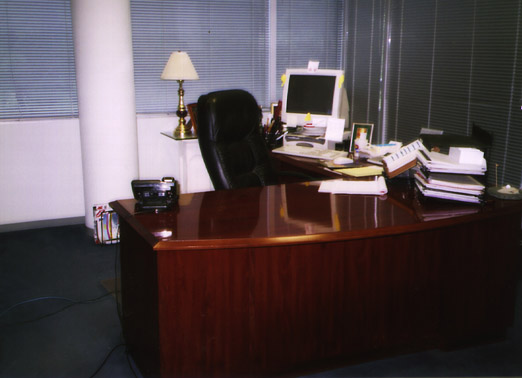
Keep it handy
Literature sorters like the one on the desk in this photo can help you stay organized by providing a home for all the papers you regularly need to file or address. Delap says using a literature sorter is “a great strategy for people who are visual, who want to see their paper all the time.” Each slot should be devoted to your most important projects in progress, to the activities you do on a regular basis, and should be labeled as such.
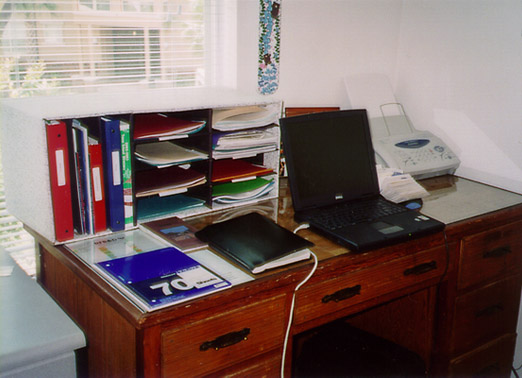
Keep paper off your desk
To prevent coworkers or family members from dumping papers on your desk, give them an alternate spot to drop off memos, expense reports, white papers, bills and other documentation. Delap suggests hanging a wall pocket (pictured) on your door or outside of your cubicle for this purpose. “People drop things on your desk because they don’t know where else to put them,” she says.
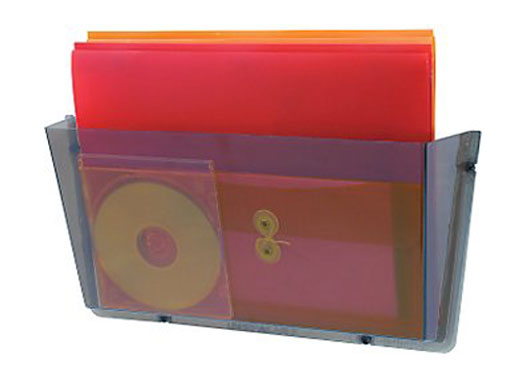
Create zones inside your home office
Many home offices double as guest rooms. When home offices are forced to perform double duty, they often end up looking like the one pictured here: a complete and utter mess. To keep multipurpose rooms neat, Delap separates them into different zones. She creates a dedicated space for work and a separate space for living or storage. You can see the results in the next slide.
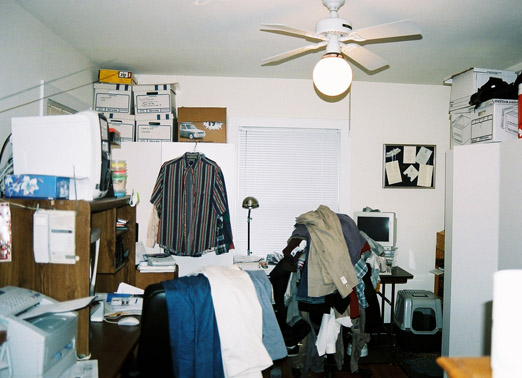
Home office redesigned
It’s hard to believe that this is the same office as in the previous slide, but it is. To achieve this pristine look, Delap put a filing cabinet under the printer, to the left of the desk, so that her client has easy access to his files. “If you can reach over and drop something into your file, it will get there as opposed to stacking up,” she says. She also put wicker baskets on the top shelf of the desk to hold extra office supplies and computer cables—items you’ll need, but that don’t need to be on your desk, taking up space in a drawer or strewn all over the floor.
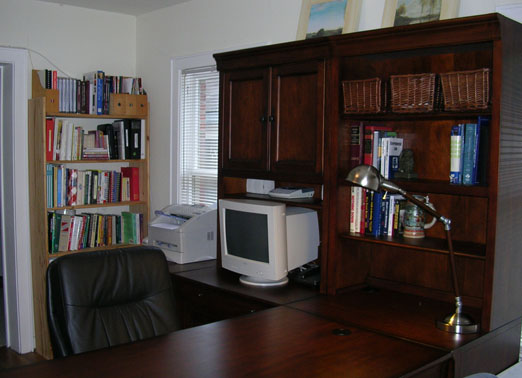
Clear your desktop
This desk is so cluttered that there isn’t a place for its owner to work aside from in front of the laptop. Having a neat desk top with space where you can work aside from in front of your computer helps you think clearly, says Delap, so always keep a portion of your desk clutter-free. She says a blotter can serve as a boundary marking the space on your desk where you read or write. Vertical and incline sorters can prevent paper and files from piling across your desk. Delap also recommends minimizing the number of knick-knacks and picture frames you keep on your desk.

Hide supplies in desk drawers
Only keep the tools you use every day on the surface of your desk, says Delap. Anything else can be hidden in a desk drawer. Bins like the ones pictured help you keep your drawers organized and everything within easy reach. They give a distinct home to all the flotsam and jetsam that might otherwise create a junk drawer.
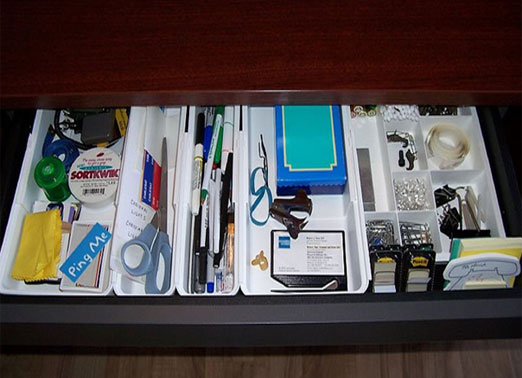
Organize your bookcase
To prevent a bookcase in your office from becoming another chaotic catch-all, Delap says to first group your books by category: technical books in one place, management books in another. Keep handy the books you use often. Delap also recommends storing all your books upright, as opposed to laying them flat. “It’s calming to see all things stored in a consistent manner,” she notes. Position your bookcase next to a credenza or behind your desk. If you use your bookcase to store other items, put those items in separate bins.
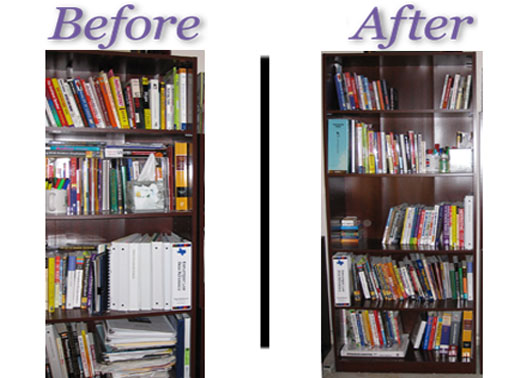
Corral magazines
Magazines, those vestiges of the 20th century, can quickly get out of hand, especially if you subscribe to weeklie. To prevent piles of magazines from mounting, Delap says to decide how long you want to keep past issues and toss any that have reached their expiration date. She notes that with so much information available online, you need to have a compelling reason to keep magazines around. If there are particular articles from different magazines you must save, rip them out and store them in a three-ring binder, she says.
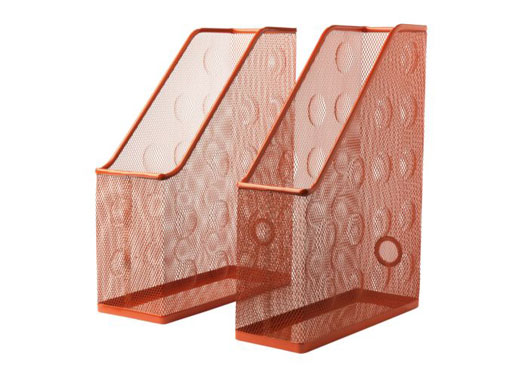
Keep a cubicle clean
Not everyone who works in a commercial office has the luxury of square footage. Toiling in a cubicle presents particular organization challenges, says Delap. Chief among them is the small space. “You really have to be decisive in a cubicle because you have so little space,” she says. “You want to be sure what you’re keeping is absolutely vital to the work you’re doing.” Delap recommends taking advantage of your cubicle’s vertical space by hanging wall pockets and file sorters from the walls.
